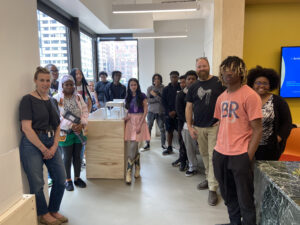By Greg Andoll
Almost every night at a corner near my home in West Baltimore men gather to gamble. They also drink, eat take-out, and, when women are present, dance and play music. Occasionally some race remote-controlled cars. Dirt bikes begin and end their wheelies at that corner. Over time, these men have taken ownership of that particular slab of concrete and made it their own.
By all metrics, it is a wildly successful place for its users. These men gather in all weather and at all times. But why that corner? There are no amenities usually associated with conventional gathering places. There is no seating, greenery, or shade. Nor is it safe. The stuffed animal memorial changes every so often. Yet, men have gathered at this spot for years.
What happens at this corner is not unique. Throughout Baltimore and the rest of the country there are certain groups, usually living on the edge, who purposefully avoid “designed” places. They prefer piers to parks, bulkheads to ball fields, alleys to allées. They often seek out the ruins of a postindustrial urban economy, to claim and transform it for their own purposes.
Such a ruin is the subject of Daniel Campo’s Book, The Accidental Playground, Brooklyn Waterfront Narratives of the Undesigned and Unplanned. In it, Mr. Campo, who is an associate professor at Morgan State University, chronicles how a parcel of land across from Manhattan changed from a ferry terminal to a garbage dump to a gentrified neighborhood park.
Much of the book focuses on its dump phase. Mr. Campo writes vividly about the characters who took over the site while its fate was decided by politicians, businesses and advocacy groups. The site, in particular a massive leftover concrete foundation known as The Slab, became a place where musicians, artists, street performers (fire spinners), skaters and others gathered. Elsewhere on the site the homeless camped. Yet others simply came to hang out and enjoy the outdoors.
The reasons that prompted these groups to use this site instead of a “regular” park are as varied as their activities. Some did not like rules that usually govern parks. Others didn’t feel welcome at more “designed” places. Still, others came to engage in questionable activity. For the fire spinners, The Slab was the ideal place to safely practice their craft.
What is intriguing about this site is that it enjoyed a level of success that would be the envy of any designer. Yet no designer played a role in shaping it. The Slab was just another piece of leftover infrastructure, undesigned and unplanned that users discovered. They made their own rules and created what they needed.
The Accidental Playground forces us to rethink what a park is and who it serves. Mr. Campo writes that there is value in having unplanned spaces for the disenfranchised. He argues that creativity is more likely to flourish, different groups are more likely to mingle, and nature is more likely to be natural in a place without rules, programming, or maintenance.
Yet even he acknowledges that in our safety conscious, litigious and capitalist society, such a place is unlikely to purposefully exist. The closest we can come to recreating The Slab, he writes, is for government and owners to turn a blind eye while sites sit idle as they are being developed, which often takes years. But even such a fleeting space is unlikely. The risks for owners and governments are too great. If a place that is free from rules, open to all and where (almost) anything goes were ever to exist again, it will indeed be accidental.
Greg Andoll is an Associate Architect at Penza + Bailey Architects
The Accidental Playground, Brooklyn Waterfront Narratives of the Undesigned and Unplanned
By Daniel Campo
304 pages. Illustrations
Available at the AIA Baltimore Bookstore
Book Review: The Accidental Playground, Brooklyn Waterfront Narratives of the Undesigned and Unplanned
Latest Gallery and Bookstore

July 1, 2024 / Center for Architecture and Design
Form + Function: AIA Baltimore exhibits the work of David Knopp
June 23, 2023 / Center for Architecture and Design
Alberto Cavalieri Work on View at Center for Architecture and Design

April 18, 2023 / Center for Architecture and Design
Baltimore Design School Architecture II Student exhibit on display now!